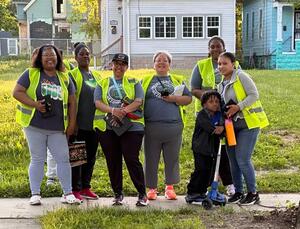
peeterv, Getty Images
Milwaukee Shows How Resident-Led Data Can Transform Housing for Communities
In Milwaukee, a city shaped by aging housing and deep-rooted racial segregation, a coalition of neighborhood organizers are harnessing community-led data to mobilize residents, reclaim neighborhoods, and rewrite a legacy of disinvestment—showing how locally generated data can be a force for equity, advocacy, and transformation.

Credit: Amy Rohan, Program Manager at Data You Can Use Milwaukee
How Milwaukee is improving housing outcomes
The city’s low- to moderate-income neighborhoods face challenges as homeowners struggle with the high costs of basic home maintenance, while renters contend with absentee landlords who are slow to make repairs. To address these systemic barriers, 10 community-based organizations formed the Reclaiming Our Neighborhoods (RON) coalition. RON conducts exterior housing surveys across neighborhoods including Amani, Burnham Park, Clarke Square, Harambee, Layton Park, Lindsay Heights, Historic Mitchell Street, Muskego Way, Near West Side, Sherman Park, Silver City, Walker’s Point, and Washington Park.
The coalition’s goals are fourfold:
- Help homeowners with low and moderate incomes access resources to maintain safe, stable housing.
- Hold absentee landlords accountable for property conditions.
- Triage distressed properties before they destabilize surrounding homes.
- Provide on-the-ground data to advocate for city programs and investments.
At the heart of this effort is the Sherman Park Community Association (SPCA) — a founding RON member— and its trusted data partner, Data You Can Use (DYCU). Over the past four years, RON has surveyed nearly 35,000 properties (PDF), including 10,000 in Sherman Park alone (PDF). Trained and compensated residents and researchers evaluated properties using a standardized survey to assess the exterior conditions of residential and mixed-use buildings, while noting litter, graffiti, and overgrowth on other property types. Properties in poor condition were flagged for detailed review, helping the coalition identify homes in need of major repairs. This data collection phase is followed by a year of direct community engagement, during which RON members go door to door to connect residents with resources tailored to their needs as renters or homeowners—while members also prepare for the next cycle of surveying.
DYCU was pivotal in modernizing the coalition’s data collection process—transitioning surveys from paper to tablets, cleaning and analyzing the data, and linking it to citywide records such as Milwaukee’s Master Property Record and tax delinquency data. They also integrated ownership information from the Milwaukee Property Ownership Network Project, which maps investor-owned LLC networks and helps identify patterns of absentee ownership.
“Data You Can Use isn’t just a data provider—they’re Milwaukee’s go-to source for neighborhood-level insight,” says Mabel Lamb, executive director of SPCA. “They’ve helped us ask better questions, move more strategically, and empower residents with knowledge.”
DYCU’s analysis powers the RON Housing Conditions Report, which breaks down property-level data by neighborhood. It found:
- A widespread need for repairs: Nearly 1 in 4 homes (22.3 percent) in RON neighborhoods need major repairs. In some areas, that number climbs as high as 47.5 percent. About 15 percent of homes need two or more major repairs.
- A high cost of repairs: It’s estimated that owner-occupied homes alone need $35 million in repairs. When including all residential and mixed-use properties surveyed, the total repair need exceeds $100 million.
- Investor-owned homes are in worse shape: Homes owned by investors are almost twice as likely to need major repairs (19.7 percent) compared with those occupied by their owners (10.3 percent).
- Tax delinquency is tied to investors: Of the 4,393 tax-delinquent residential properties surveyed, nearly 60 percent are investor owned—even though investors own fewer than half of all homes. These investors owe the City of Milwaukee nearly $6.5 million in unpaid property taxes.
- Opportunities lie in vacant land: Vacant lots make up 7.5 percent of all properties surveyed—more than 2,600 parcels—highlighting potential for redevelopment and community reuse.
This data-driven approach has enabled SPCA and its partners to identify homes in need of repair, track ownership patterns—including absentee landlords—and connect residents with vital resources such as $5,000 home repair grants, estate planning services, and first-time homebuyer programs.
These insights also fuel advocacy. RON members are pushing for increased local funding for home repairs, stronger accountability for negligent property investors, and solutions to address tax delinquency and city-owned vacant properties. To further support these efforts, DYCU is developing a targeted investor report that will spotlight “bad actor” landlords who own multiple poorly maintained properties across RON neighborhoods—strengthening the case for policy and enforcement reforms.
Milwaukee remains one of the most segregated cities in the country, and the RON coalition is confronting this legacy head-on. With DYCU’s support, SPCA is partnering with the Redress Movement and local officials to uncover racial covenants and advocate for expanded housing opportunities beyond historically segregated areas.
“Just educating residents about the existence of racial covenants has been powerful,” says Lamb. “It’s about truth-telling—and building a long-term strategy for equity.”
Lessons for other communities
Milwaukee’s experience shows that when trusted community organizations like SPCA and DYCU collaborate through coalitions like RON, community-led data becomes a powerful tool for advancing equity, advocacy, and neighborhood transformation. Here are a few takeaways for other communities looking to adopt similar approaches:
- Invest in community-led data collection. Empowering residents to participate in data collection builds trust, ensures local relevance, and surfaces issues that top-down approaches may miss.
- Build strong partnerships. Collaborations between grassroots organizations and data experts bridge the gap between lived experience and policy action. Connecting with the National Neighborhood Indicators Partnership (NNIP) can be a useful first step in finding the right data partner in your city. In communities without an NNIP partner organization, the network also has guidance for how to locate trusted local data partners (PDF).
- Use data to drive both services and systems change. Local data can help connect residents to immediate resources while informing long-term advocacy and structural reform.
- Pair data collection with direct engagement. Following surveys with door-to-door outreach ensures residents benefit from the data they help generate and strengthens community relationships.


